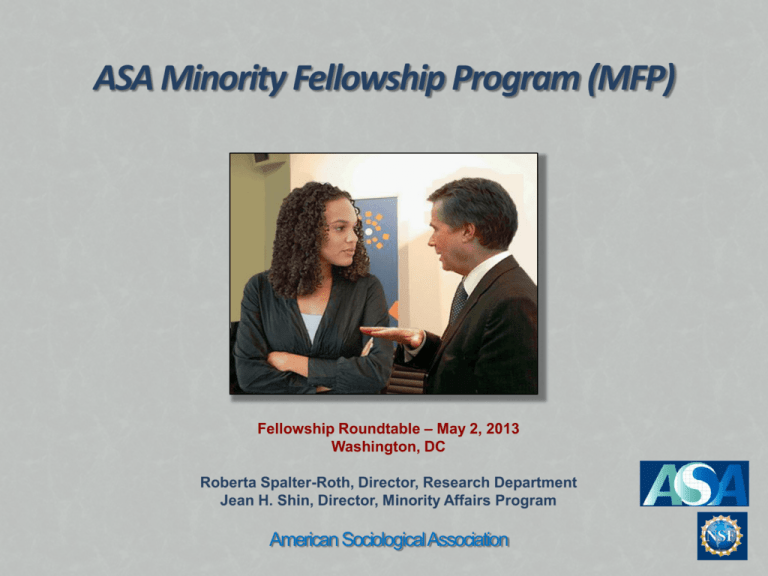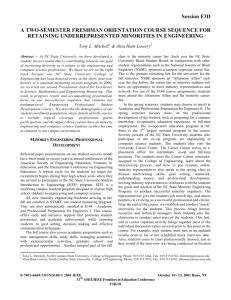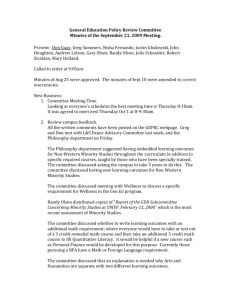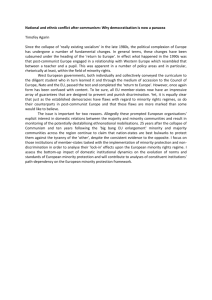Slide 1 - American Sociological Association
advertisement

ASA Minority Fellowship Program (MFP) Fellowship Roundtable – May 2, 2013 Washington, DC Roberta Spalter-Roth, Director, Research Department Jean H. Shin, Director, Minority Affairs Program American Sociological Association Information on the ASA Minority Fellowship Program • Pre-doctoral training program founded in 1974 at the behest of the thenCaucus of Black Sociologists (now the Association of Black Sociologists). • MFP was founded around the same period as similar training programs in psychology, nursing, and social work (funded by the National Institute of Mental Health). • The original purpose of MFP was to address the severe underrepresentation of senior minority scholars as campuses became more diverse. • Then and still today, MFP has been inclusive of all racial/ethnic minority groups in the discipline. MFP Background, cont’d • Notable MFP alumni from Cohorts 1-10 (with current affiliation): • • • • • • • • • • • • • Gary Sandefur, University of Wisconsin-Madison Matthew Snipp, Stanford University Patricia E. White, National Science Foundation Ruth Peterson, Ohio State University Verna Keith, Texas A&M University Aldon Morris, Northwestern University Mary Romero, Arizona State University Dana Takagi, University of California, Santa Cruz Patricia Hill Collins, University of Maryland-College Park Linda Burton, Duke University Lawrence Bobo, Harvard University David T. Takeuchi, University of Washington Rogelio Saenz, University of Texas-San Antonio Changes in the Minority Fellowship Program • Funded through 2010 by the National Institute of Mental Health (NIMH), with a peak of 30 full stipend lines per year in 2000-2005 (26 federally-funded through T32 grant mechanism, 4 ASA–funded). • Now 5-6 lines each year, funded entirely by organizational partnerships and individual contributions (including the MFP Leadership Campaign). Formerly multiyear awards, now 1 year in duration with no renewal. • Professional development activities/events at the ASA Annual Meeting. • Contributing to ASA’s fundraising prospectus, we did a comparative outcomes evaluation of MFP alumni over 10 years and two other groups. • MFP is one of very few national fellowship programs that has done this sort of systematic evaluation. Mentoring, Networks and Resources for “Ideal” Minority PhD Career Trajectories: An Evaluation of the ASA Minority Fellowship Program Fellowship Roundtable – May 2, 2013 Washington, DC Roberta Spalter-Roth, Director, Research Department Jean H. Shin, Director, Minority Affairs Program American Sociological Association Synopsis of ASA-Sponsored Research on Mentoring and Networks Today, we present findings from two-NSF-funded studies on minority career trajectories in sociology (NSF grant #0936783). • The first study, a quantitative analysis, emphasizes cross-race mentoring for an “ideal” career trajectory in the first 10 postPhD years. • The second, a qualitative analysis, emphasizes dualisms or the “two worlds” of mentoring, networks, and resource distribution that minority PhDs need to navigate. Slide 2 First ASA Study: Cross-Race Mentoring • What are the effects of instrumental and communal mentoring on long-term career outcomes of minority PhD graduates and the likelihood of having an “ideal” post-PhD career trajectory? • Do the two types of mentoring level the playing field for minority scholars? Slide 3 Instrumental (or individual) mentoring is measured by having a white male dissertation advisor because these advisors have more resources and contacts and concentrate on ideal career paths. Psycho-social (or communal) mentoring is measured by participation in ASA Minority Fellowship Program (MFP) because this is a support network for minority scholars. “Ideal” Post PhD Outcomes Ideal post PhD outcomes include: Slide 4 Employment at a Research I university High number of articles published Receiving NSF and/or NIH grants ASA section leadership Comparison Groups In order to evaluate MFP outcomes and whether the program leveled the playing field we compared three groups: 1. Participants in the ASA Minority Fellowship Program (MFP) 2. Participants in the NSF Dissertation Improvement Grants in Sociology 3. A randomly selected group of PhDs in sociology Slide 5 Data Three comparison groups: • All 1997-2006 MFP Fellows. • All 1997-2006 NSF Dissertation Improvement Grant recipients. • 200 randomly selected PhD graduates from the same years. PhDs: • Received PhD between 1996/1997 and 2008/2009 academic years. • Employed in the U.S. in 2010. Sources of data: • ASA records. • NSF and NIH records. • Faculty and department websites. • ProQuest database. Independent variables: • Race/ethnicity and gender. • Participation in MFP or receiving NSF Dissertation Improvement Grant award. • Dissertation advisor’s race. • Type of graduate program. • Years since graduation. For more information see a research brief titled The Impact of Cross-Race Mentoring for “Ideal” and “Alternative” PhD Careers in Sociology at www.asanet.org/images/research/docs/pdf/Impact_of_Crossrace_Mentoring_Report_2011.pdf. Slide 6 Sample Characteristics Variables Demographic Characteristics: Female Minority Missing race/ethnicity Graduate School Information: PhD from a Research I university Year since graduationa Primary Dissertation Advisor: Minority female White female Minority male White male Missing advisor's race/ethnicity 2010 Employment: Research I institution Number of Cases Slide 7 Randomly Selected PhDs MFP Fellows NSF Awardees 61.6% 22.0% 11.9% 61.1% 100.0% 0.0% 59.8% 13.9% 10.5% 71.1% 82.4% 97.7% 7.5(3.6) 7.5(3.7) 5.9(2.9) 3.8% 31.4% 5.1% 49.1% 10.7% 11.1% 27.8% 13.9% 38.9% 8.3% 1.5% 31.6% 3.4% 55.6% 7.9% 15.2% 11.1% 36.8% 159 108 266 MFP Fellows and White Dissertation Advisors • Having a white male advisor significantly benefits MFP participants in obtaining Research I faculty careers, although this type of relationship does not have significant effects on the other comparison groups. • Employment at a Research I university, in its turn, directly affects scholarly productivity, grant awards, and professional service for all groups. Slide 8 Expected Probability of Academic Employment at a ResearchExtensive University in 2010 for 1997-2009 Sociology PhD Graduates in Academic Positions by Group and Advisor 60% 51% 49% 32% 40% 34% 33% 7% 20% 0% Randomly Selected PhD Graduates MFP Fellows NSF Awardees Note: Results are from hierarchical logistic regression with robust standard errors, population mean estimates. Control variables are held constant at the means for randomly selected PhD graduates. Department-level variance held constant at zero. Mixed Findings for the Type of Mentoring and Scholarly Productivity • Publishing with a dissertation advisor increases post-PhD publication rate for all groups. • MFP Fellows are twice as likely to graduate with a published article in their portfolio when they have a minority rather than a white male advisor. Published at Least One Article Prior to Graduation by Kind of Advisor Randomly MFP Fellows Selected PhD Graduates Minority advisor (male or female) White female advisor White male advisor 12.5%(8) 12.5%(32) 17.3%(52) 21.4%(14) 10.5%(19) 11.5%(26) • Post-graduate publication rate among MFP Fellows is not statistically different from the publication rate of randomly selected white PhD graduates, controlling for other factors. This suggests the importance of minority advisors. • MFP Fellows publish significantly less in the top three sociology journals (ASR, AJS, Social Forces) than the randomly-selected white PhD graduates. Slide 9 Leveling the Divide – Research Grants and ASA Section Leadership • Compared to randomly selected white PhD graduates, former MFP Fellows who are tenure track or tenured faculty are: More than 2 times more likely to receive NSF and/or NIH research grants (controlling for other factors). About 4 times more likely to be elected as an ASA section officer (controlling for other factors). • Thus, MFP does help to level some of the racial/ethnic divide, although not in terms of publications in “top” journals. Slide 10 MFP Women and Men • But, MFP appears to bring more advantages to minority men than to minority women. • MFP does not erase the “double disadvantage” at the intersection of race/ethnicity and gender. Scholarly Productivity and Employment MFPs by Gender MFP Fellows Men Women Employed at a Research I University At Least One Publication with Mentor prior to Graduation Mean Total Number of Publications since PhD Graduationa At Least One Article Published in Top Sociology Journals Received NSF and/or NIH Grants ASA Section Officer Service a Slide 11 Standard errors are in parentheses. 31.8% 27.3% 5.5(1.5) 4.6% 22.7% 18.2% 16.7% 9.5% 2.7(0.5) 4.8% 11.9% 11.9% The Two Worlds • This research seeks to better understand the experiences of minorities in higher education. In doing so, we examine the concept of “dualisms” or two worlds experienced by minority graduate students and early career faculty. • These dualisms reflect the structured inequalities of a white dominated academy with minorities participating in the “two worlds”--one homogeneous, and less powerful, and one heterogeneous, and more powerful. The notion of two worlds was conceptualized by W.E.B. DuBois. • Minority scholars can either accommodate to or attempt to overcome these inequalities. Studying dualisms and the “two worlds” allow us to not only examine power relations and structural inequalities, but also how minority scholars navigate these worlds. Slide 12 Second Study: Exploratory Qualitative Analyses of the Two Worlds Working paper titled Navigating “Dualisms:” The Challenge of Access to Mentoring, Networks, and Resources in Minority Graduate Students’ PhD Career Trajectories Based on 33 qualitative responses to these questions: Slide 13 • Who do you consider to be your mentors? Please describe their roles in your professional development. Are they similar to you in terms of race and gender? • Are you involved in any networks that promote your scholarship and career development? Is the ASA Minority Fellowship Program one of these networks? Are these networks comprised of people who are similar to you in some way? • In your department, how are resources such as funding, mentoring, travel support, and opportunities to interact with faculty members, distributed? Do you think this distribution is equitable? Dualisms or The Two Worlds that Minorities Need to Navigate Dualisms identified by the survey respondents: Instrumental versus psycho-social mentoring – Instrumental mentoring addresses students’ skills and competencies. – Communal or psycho-social mentoring is concerned with students’ emotional needs and well-being. Homophilous versus heterogeneous networks – Homophilous networks are segregated by race/ethnicity and gender. – Heterogeneous networks cross these lines. Universalistic versus particularistic distribution of resources – Merit or universal distribution of resources. – Particularistic or biased distribution. Slide 14 Instrumental Versus Psycho-Social Mentoring • In this research, respondents expressed a desire for holistic forms of mentoring, although not necessarily in the body of the same person. “My dissertation advisor very much is the instrumental one – white male. I’m a woman of color. My emotional or psycho-social mentor is the one that keeps me sane and is a woman of color. She helps me navigate the space that was never meant to be for me.” Slide 15 Homophilous Versus Heterogeneous Networks • They expressed a desire to continue to have both homophilous and heterogeneous networks. “Networks, and especially the MFP, have put me into contact with faculty of color from other institutions and I have felt a direct impact from this both in my funding situation and in the quality of my scholarship. It is also possible that the great mentorship I received at Northwestern is due to the prestige of being awarded an MFP. Often at the ASA or at other professional meetings I have been able to start a conversation or get a faculty member to give me some of their time via their former membership in the MFP…This helped me prepare both for National Science Foundation dissertation grant (which I was able to get) and the RWJ which I recently applied for. The MFP networks put me in touch with faculty members that were willing to give me "insider information" that I might not have otherwise gotten about these fellowships, presentations, and other opportunities.” Universalistic Versus Particularistic Distribution of Resources • They saw contradictions between universalistic norms of resource distribution and inequalities in actual distribution. “The distribution of resources in my department is highly uneven. There is a general disrespect for qualitative work and race work with a critical edge. This, coupled with highly uneven levels of involvement from mentors can create some conflicts about who gets what. I have been lucky with my mentors but several other students of color in the department have not been successful in getting outside finding, and they are forced to teach every semester. This has clearly hindered their progress on publication. To change this, departments should ensure that TA/RA assignments are distributed evenly or rotated.” Conclusions • For existing programs like MFP, there has been a good deal of success in terms of moving numbers of minority PhDs into “ideal” careers, in a framework that understands the “twoness” experienced in academic environments—by producing both heterogeneous and homogeneous mentoring and networks—although MFP does not level the playing field with the random (largely white) group. • Much still needs to be learned about the choices minority scholars make in their careers. • From our second study, we suggest that early-stage sociology scholars of color appear to be aware of the existence and need to navigate the two worlds of different types of relationships and practices (using DuBois’ conceptualization). Slide 18 Suggestions and Next Steps • First, we suggest that until science becomes less of a white-dominated world, the desire of minority scholars to be part of an alternative, racially homogeneous world continues, even if it has fewer resources. • To this end, we suggest the formation of more discipline-wide “intervention” programs for minority scholars including students, early career faculty, and senior scholars of color to overcome the paucity of minority scholars in departments and challenges to maximizing success. • Second, we suggest that departments ensure that instrumental mentoring by those faculty members (usually senior white males) with the most contacts and resources are available to minority students, and that these faculty are held accountable. Slide 19 Suggestions and Next Steps (continued) • Perhaps more training might be necessary so that faculty, especially white male mentors, can feel comfortable with psycho-social mentoring. • Reasons for differential resource distribution should be clearly stated. Next Steps • By triangulating two types of data, we expect to better understand why a move simply toward more equal representation in terms of recruitment and retention is not enough. • As demographic changes continue to take place, it is important to expand DuBois’ classic notion of “double consciousness” to include a more “intersectional” consciousness by particular racial/ethnic, gender, sexual orientation, class, and other social identities to disentangle the relationship between opportunity, merit, support, and heterogeneity. Slide 20 Feedback From You • Finally, this evaluation is limited to sociology PhDs. • We are interested in obtaining more comparisons from other programs and other disciplines. Thank You! For further discussion or help, contact Roberta Spalter-Roth, PhD, at 202-383-9005 ext. 317 or by e-mail at spalter-roth@asanet.org. Also, please plan to visit the ASA’s home page at www.asanet.org for links to this presentation and other ASA research briefs and articles. Slide 22






